One of the things I’ve missed since moving north from our country home in Texas 13 years ago has been having chickens, and our own fresh eggs. Having a new grandbaby made my chicken longing all the more compelling–I might be able to accept eating store-bought eggs for myself, but my granddaughter must have only the best and most nutritious!
Being a busy grad student and nurse meant I thought I didn’t have time for DIY projects, so my original intent was to purchase a pre-made coop and chicken run. To my amazement, I found a chicken tractor on Amazon.com–with FREE super saver shipping! I happily placed my order.
A week later, Amazon informed me my order had been canceled due to unavailability. Frustration set in. I searched in vain for another source, but couldn’t find anything I liked as much that was within my price range. It seemed that building my own was my only option, but I didn’t see how I possibly could. For one thing, we don’t have much in the way of woodworking tools. Also, finals week was fast approaching, and “spare” time was at a premium. I needed to come up with something I could do quickly and easily, without too many fancy tools. Here’s what I came up with:
I bought a Rubbermaid storage shed at Home Depot.
Inside, I added a roost and a rack to hold the “nestbuckets” made from Home Depot buckets. I also made a screened wall on one side, so that one door can be left open for ventilation during nice weather.
To secure the wooden fixtures, I drilled holes through the walls of the coop and screwed wood screws through from the outside into the wood pieces. Where possible, I took advantage of the shapes and depressions of the plastic to add additional support. The screen wall is fastened to the wall of the coop and also to the roosts. The nestbuckets are not permanently fastened to the rack they sit on — I use a bungee cord to hold them securely in place.
In the back of the coop, beneath the nestbuckets, I cut an opening for the chickens to use for going in and out. I made a mistake and made it flush with the floor, before realizing that there should be a “lip” to hold the bedding in, so I added a scrap piece of lumber across the bottom for that purpose. I used strips of trim to “frame” the opening and hide the hollow walls of the Rubbermaid container.
Since there’s no way to keep the right-hand door closed when the left-hand one is open, I added gate latches on the inside to fasten it to the screen door. I can easily reach the lower one by reaching down through the top of the coop, but for people whose arms aren’t as long as mine, a pull string could be rigged for that purpose.
The last step was to add four eye bolts to the outside of the coop, to secure it to the run (I’m using bungee cords for this purpose), and to add strips of 2×2″ lumber to use as handles, since the smooth plastic makes it hard to get a grip on it for transporting the coop.
The run is made from two cattle panels with 2×4″ openings, using pig rings to secure the pieces together. The sides and top are each a half panel. The remaining piece was cut into 3 parts. Two of them form the end of the run farthest from the coop. The bottom half is fastened permanently in place, and the top half is fastened only at the top, forming a hinge that allows it to be swung up onto the top of the run for access to the inside. Again, I used a bungee cord to fasten the access panel in place when it is closed. I’m tall enough to easily step over the lower piece, but someone without my height advantage might need to modify the design to work for them. The remaining thin piece of cattle panel was fastened vertically to one side of the end of the run next to the coop. It adds some structural stability as well as allowing for the fact that the coop is not quite as wide as the run. A 2-foot wide strip of hardware cloth with 1/2″ openings was fastened all the way around the lower portion of the run, to keep raccoons from reaching through to grab the chickens.
Finally, I fastened a tarp over the run at one end to protect the feed from rain. Here’s the finished product, complete with chickens:

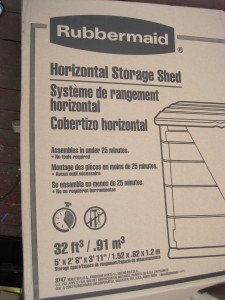
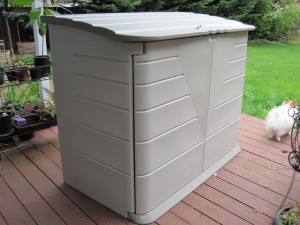
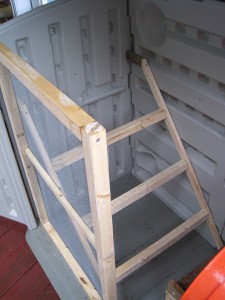
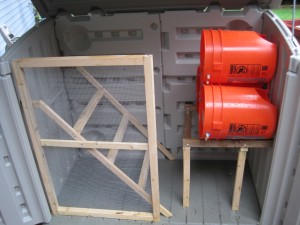
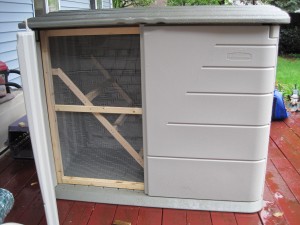


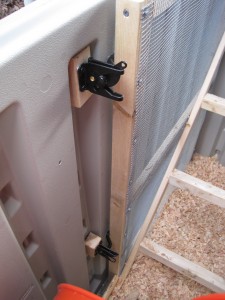
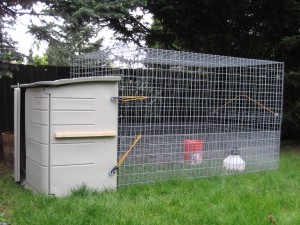
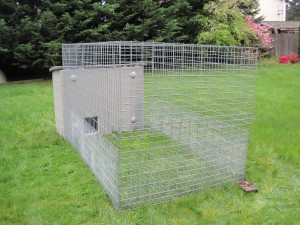
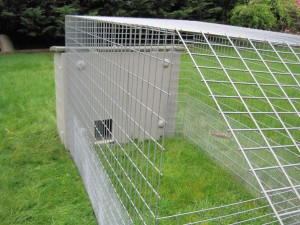
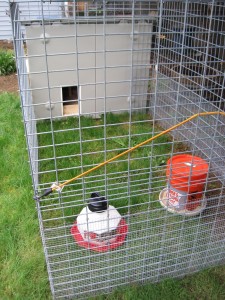
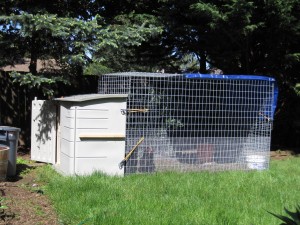
17 Responses to My DIY Chicken Coop and Run